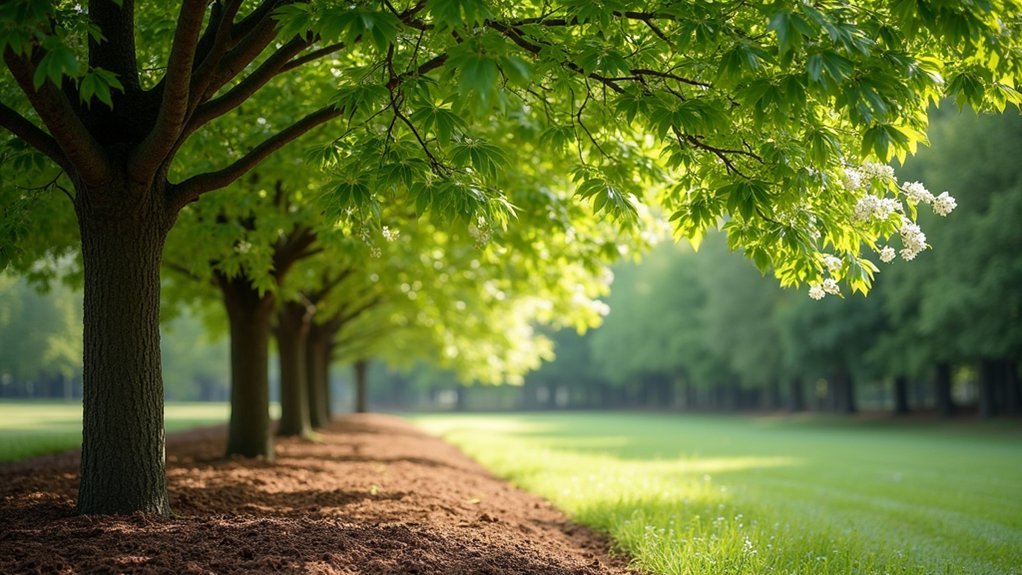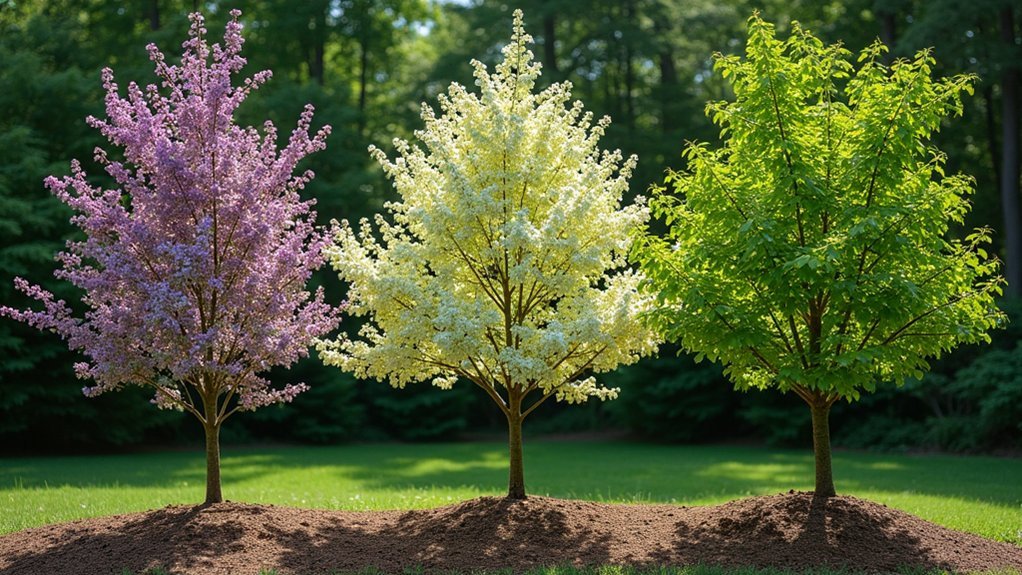The three best understory trees for property boundaries are Flowering Dogwood, Eastern Redbud, and Rusty Blackhaw Viburnum. You’ll appreciate Dogwood’s attractive blooms in partial shade, while Redbud creates natural screening while attracting pollinators. Rusty Blackhaw forms excellent visual barriers with berries that birds love. All three require minimal maintenance once established and support local wildlife through distinctive features and seasonal interest. Discover how these native alternatives outperform traditional fencing options.
Native Understory Trees That Create Natural Boundaries

While establishing privacy along property lines often leads homeowners to install fences or hedges, native understory trees offer a more ecological and visually appealing alternative.
You’ll find options like Flowering Dogwood and Eastern Redbud that create natural boundaries with their attractive foliage and seasonal blooms while thriving in partial shade.
Consider Sassafras with its unique leaf shapes and vibrant fall colors, or Rusty Blackhaw Viburnum, which forms effective visual barriers while producing berries that attract birds, enhancing biodiversity.
Native understory trees like Sassafras and Rusty Blackhaw Viburnum create natural privacy while supporting local wildlife through their distinctive features.
Eve’s Necklace provides shelter for wildlife while defining your property’s edge.
These native understory trees require minimal maintenance once established and contribute considerably to soil stability and ecological health.
They’re ideal for homeowners seeking sustainable, beautiful solutions that benefit both landscape aesthetics and local ecosystems.
Selecting Understory Trees for Wildlife Habitat and Privacy
Creating a thriving boundary with understory trees means striking the perfect balance between privacy needs and wildlife benefits. When selecting native species for your property line, look for those that serve dual purposes—Eastern Redbud and Flowering Dogwood not only block unwanted views but also attract pollinators and provide essential habitat.
For maximum ecological impact, consider:
- Serviceberry and Sassafras, which offer food sources for birds while creating effective privacy screens
- Trees with varying heights and growth habits to establish a multi-layered boundary that supports diverse wildlife
- Drought-tolerant options like American Smoke Tree that require minimal maintenance once established
Your tree planting strategy can simultaneously address soil erosion and improve your property’s microclimate.
Care and Maintenance of Boundary Understory Plantings

Successful boundary plantings demand consistent attention and care, especially during the vital first two years after installation.
You’ll need to establish regular watering schedules, adjusting frequency based on rainfall and soil moisture levels to support healthy growth.
Apply a 2-3 inch layer of mulch around your understory trees, keeping it several inches from the trunk to prevent rot while suppressing weeds and retaining moisture.
Mulch your trees properly—thick enough to suppress weeds, distant enough from trunks to prevent moisture damage.
Pruning is essential—remove dead or damaged branches to improve air circulation and maintain attractive shapes.
In early spring, apply a balanced, slow-release organic fertilizer, particularly in nutrient-deficient soils.
Don’t overdo it—excess fertilizer can damage roots and reduce flowering.
Maintain vigilant pest control through regular monitoring.
Inspect leaves, branches, and bark monthly for signs of infestation or disease, intervening quickly to protect your boundary investment.
Frequently Asked Questions
What Is the Best Tree to Plant on a Property Line?
You’ll find Eastern Redbud ideal for property lines with its 20-30 foot mature height, seasonal beauty, and manageable size. Drake Elms and Texas Redbuds also work well in various soil conditions.
What Are the Best Understory Shade Trees?
For understory shade trees, you’ll love Eastern Redbud for spring blooms, Flowering Dogwood for wildlife support, and Japanese Maple for vibrant foliage. They’ll thrive beneath larger trees while adding color and dimension to your landscape.
Which Tree Is Best for Boundary?
For your boundary, Eastern Redbud is best as it won’t overwhelm structures at 20-30 feet tall. You’ll appreciate its visual separation while Drake Elm offers faster growth if you’re looking for quicker results.
What Plants Are Good for Dividing Property Lines?
For dividing property lines, you’ll find Eastern Redbud, Flowering Dogwood, Texas Redbud, Yaupon Holly, and Serviceberry are excellent choices. They’ll provide beauty, wildlife habitat, and natural boundaries while respecting neighboring spaces.
In Summary
You’ll find these three understory trees perfect for defining your property line while adding beauty and habitat value. Plant them with proper spacing, guarantee they receive appropriate care, and you’ll enjoy a natural boundary that thrives for decades. Remember to check local regulations before establishing any living fence, and consider consulting with a landscape professional for the best placement.





Leave a Reply